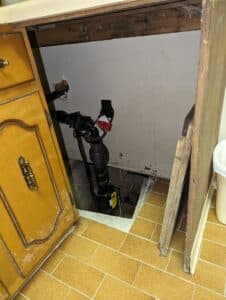Sump pump in your basement
First, check if any rebate programs running in your municipality
Basement Flooding Protection Subsidy Program
https://www.toronto.ca/services-payments/water-environment/managing-rain-melted-snow/basement-flooding/basement-flooding-protection-subsidy-program/
Enhanced Basement Flooding Prevention Subsidy Program
Those dealing with plumbing discharge have mixed feelings about burying a sump pump discharge pipe. It certainly looks better, but homeowners wonder if it's truly an efficient way of doing things.
Other concerns revolve around the environment, such as whether a discharge pipe can harm the soil composition or groundwater. Plumbing experts agree that it's safe to bury your discharge line and that it is the best way to avoid problems with your sump pump.
You should know more about your sump pump and how it works before you decide how to handle your sump pump discharge pipe.
How Does a Sump Pump Work?
Homeowners have probably heard the term "sump pump" and have a basic idea that it's to prevent flooding in the home. However, most can't describe how it works. Understanding the mechanics of a sump pump helps you decide whether to bury it or not.
A sump pump detects when water levels are rising in your basement and moves it out before it causes damage. It sits in a pit, which is created below your basement floor, called a basin. That's where the valves sense water elevation or pressure. When there is excess water, the pump moves the water away from the property through a discharge line called an effluent. The effluent runs from the sump pump to a drainage area chosen to handle the discharge.
Possible Problems with Discharge Lines
Sump pump discharge lines aren't infallible and there can be occasional problems. However, those that are installed well and buried properly won't have many problems, if any at all.
Some line problems include a line that can get broken or removed, be frozen by snow, or isn't long enough to run from the home to the designated location. These are the types of problems that can happen when the discharge line is left above ground.
Those left to run on top of the yard can be broken by those doing yard work or other maintenance. They can be removed when people are doing work around the home or be buried by dirt and grass, which can lead to them being blocked or damaged. Freezing in snow and ice is more likely when they are left on top of the ground.
Burying the pipe keeps it safe and can help prevent freezing because it doesn't come in contact with air or snow. Burying a pipe can resolve issues of pipes that are too short as long as the emptying spot meets the same standards and the designated spot for discharge.
Where Should It Drain?
The designated area should be a place that can handle additional water like a creek or pond, a neighborhood drain, or a dry well. It should be located at a downward decline from your home so gravity will take the water to the spot.
Any spot picked should be somewhere where the water can't return to your home. Most experts say it should be at least 10 to 20 feet from your home's foundation to avoid it returning.
Cities and counties have codes that govern where you can drain your sump pump discharge. Check with the building codes department at your local government to find out what types of regulations exist.
In some cases, you may have a designated area that is further away than most and that requires an extended drain hose. Those that get a longer pipe or a drain hose extension will need to boost the power of the sump pump to push the water further.
Is Sump Pump Discharge Dangerous?
Sump pump discharge isn't dangerous to people or the environment. All it is is rainwater or excess water coming from either a busted home water pipe or some other source. The water is clean so it's safe to go into creekbeds, dry wells, and other areas that collect water.
The Cost
Bear in mind that burying sump pump discharge pipes will cost additionally. The cost depends on how far the local government requires that you put your drainage spot from your house. Extension hoses and longer lines will increase costs. You will also need a permit to install a sump pump.
The Value of Sump Pumps
While it costs additionally to install a sump pump and the discharge line, it is a necessary item for homes to keep them from flooding. Most are used to keep basements dry, they are also used to protect crawl spaces and keep similar foundation spaces dry.
Keeping basements dry prevents mold and mildew and that helps keep your home healthy.
To Bury or Not to Bury
One of the primary reasons most people bury a sump pump discharge pipe is that burying it improves the look of the yard. An unburied pipe makes the yard look unfinished and can lead future potential buyers to question whether the basement floods or has other problems.
However, there are other solid reasons to bury the sump pump discharge pipe. Mostly, burying it keeps it functional for years to come and helps you avoid replacement.
Burying the sump pump discharge line not only protects the line from damage and freezing but also prevents it from becoming a safety hazard to kids playing, people working in the yard or even animals roaming. It keeps them from getting blocked and looks nicer in the yard than exposed lines.



